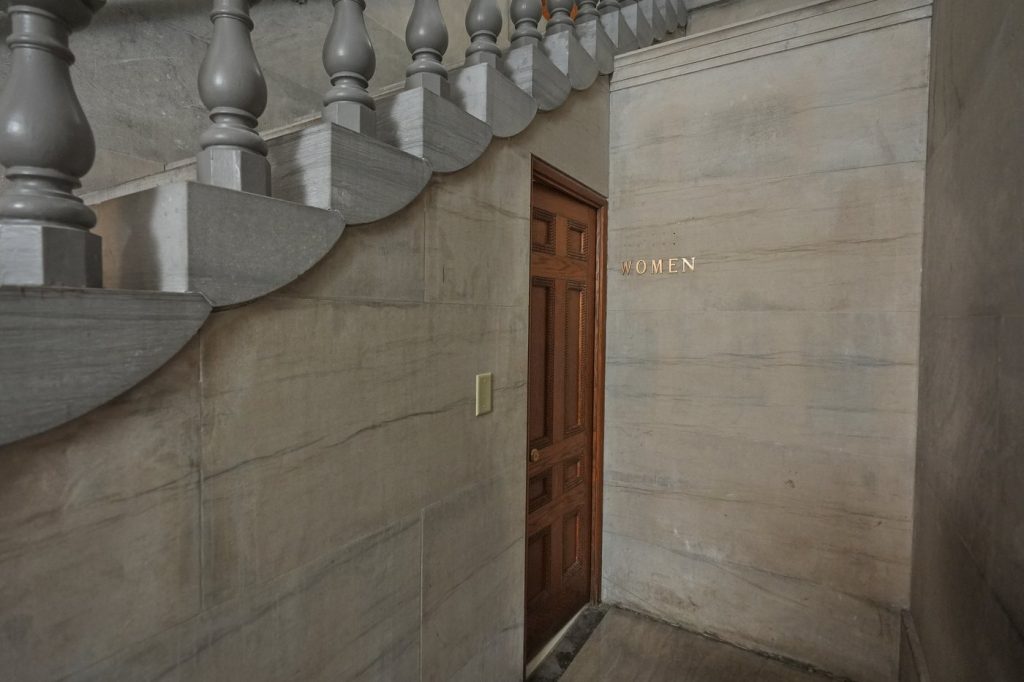The issue of bathroom access for female lawmakers in Kentucky highlights a significant disparity in the design and accommodations of state legislative buildings. Female legislators, who make up 41 of the 138 members in the Kentucky Legislature, face a challenge when they need to use the restroom during lengthy floor sessions. The third floor of the Kentucky Statehouse has only two stalls available for women, while male legislators benefit from multiple restroom facilities. This results in women having to carefully calculate their bathroom visits to avoid missing critical debates and votes.
House Speaker David Osborne has allowed women to use his single stall bathroom in the chamber during emergencies, but even this option leads to long waiting lines. Representative Lisa Willner, a Democrat from Louisville, expressed her frustration, saying, “You get the message very quickly: This place was not really built for us.” This sentiment is echoed by many female lawmakers who feel that the environment in which they work is antiquated and designed without consideration for their needs.
Experts like Kathryn Anthony, a professor emerita at the University of Illinois, argue that the lack of adequate restroom facilities is not merely a logistical issue but one that reflects deeper cultural problems. Anthony asserts that the built environment should accommodate all members of the population; neglecting women in state legislatures leaves them feeling disenfranchised and marginalized.
There is, however, hope for improvement. A scheduled $300 million renovation of the Kentucky Capitol, anticipated to be completed by 2028, aims to address this bathroom disparity by adding more facilities for women. Kentucky is among the last states to make such changes to its aging statehouse facilities, which were originally built without the consideration of female legislators.
Similar renovations are taking place in other states as well. For instance, Georgia is prioritizing expanding bathroom access in its $392 million renovation of the Capitol, which will include new female facilities on the fourth floor. As statehouses have evolved over time, they have gradually added restrooms for women, reflecting the changes in the makeup of their legislative bodies.
The absence of a federal law dictating public restroom access for all genders is notable, with only around 20 states having statutes regarding restroom availability. Many historic buildings, including statehouses, are often exempt from these rules. Over the years, as female representation in state governments has increased, the push for greater bathroom accessibility has gained prominence.
A historical context provides insight into how far some facilities have come. Tennessee’s Capitol, constructed in 1859, initially contained only one restroom for men on the ground floor, leading to absurd situations where toilets were functioning only with collected rainwater. Over the years, this has changed, but the current women’s restrooms still face limitations such as cramped spaces and fewer stalls compared to the male counterparts.
Women who have served in state legislatures, like New Mexico's Representative Liz Thomson, recall instances where the lack of adequate facilities directly impacted their duties, such as missing votes due to insufficient restroom options. Her experiences underscore how such issues, while seemingly trivial, relate to respect and inclusion within the legislative process.
In the U.S. Capitol, the first restroom designated for congresswomen did not open until 1962, highlighting the broader trend of gender discrimination in public facilities. It wasn't until 2011 that a restroom was opened to women lawmakers in the House chamber, reflecting a long-standing oversight of women's needs in governmental buildings.
Ultimately, as women like Lisa Willner continue to advocate for their rights and needs within the legislative environment, the ongoing conversation about bathroom parity signifies a critical step toward ensuring equal representation and respect for all lawmakers. The design of legislative spaces must evolve to reflect the changing demographics of those who serve within them.










